With ever-increasing interest and development in the metaverse and other graphics-intensive technologies like augmented reality (AR) and virtual reality (VR), high-end graphics rendering is going to be in high demand in the years ahead. The decentralized Render Network is taking a novel approach to high performance computing (HPC), prompting us to take a closer look.
What is Render Network?
The Render Network is a decentralized network that connects those needing computer processing power with those willing to rent out unused compute capacity. Those who offer use of their device’s unused graphics processing unit (GPU) are rewarded with render tokens (RNDR), the native utility token of the Render Network.
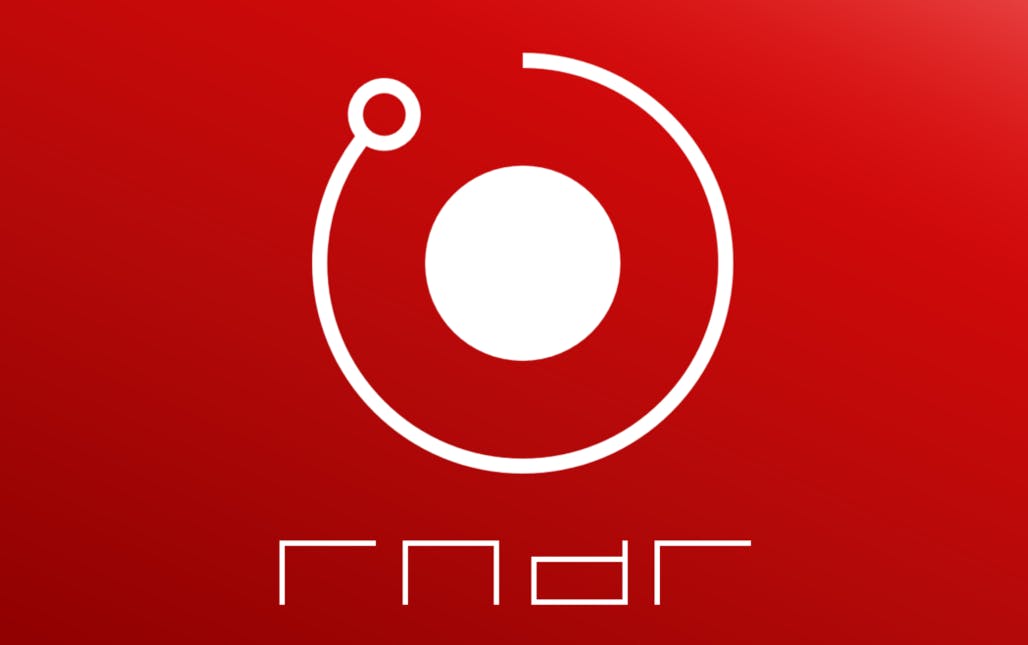
The distributed network was founded in 2016 by Jules Urbach. Maximum token supply was set at 536,870,912 RNDR tokens. 25% of that supply was issued via an initial coin offering (ICO) to raise funds to finance the project.
Render Network is trying to make the process of rendering and streaming videos and metaverses much easier while enhancing the user experience. It will be much better to have an array of GPU devices render resource-intensive graphics for you as a user rather than have your own device struggle under that burden, detracting from the user experience.
The metaverse is at an embryonic stage although it is destined to have the highest GPU compute requirement of all once it is fully developed and adopted. But for right now there’s already more than enough demand. Do you access TikTok and YouTube content? How about Netflix, Hulu or HBO Max? They all involve resource-intensive rendering. Surgeons and architects are also increasingly utilizing systems that implicate 3D modelling, together with technologies based on augmented reality (AR) and virtual reality (VR).
How Render Network distributes rendering
Before we consider precisely how the Render Network works, let’s recap on what rendering is. The process of rendering is also known as image synthesis. It involves the transformation of 2-dimensional or 3-dimensional models into an image or scene that is photo-realistic. Put simply, it means converting raw data into displayable graphics.
Creators are those that need to access the GPU compute capability. On most blockchains, node operators are responsible for running the network’s software with the purpose of either validating transactions or otherwise, securing the network. On the Render Network they take on a different role entirely as node operators are those who offer up their spare GPU compute capacity.
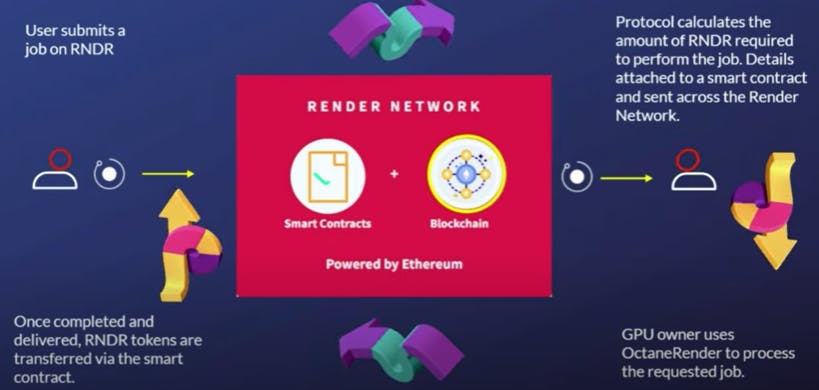
There are 6 steps for a creator in accessing the service:
Creating a job: Creators submit their jobs using a supported plugin integration or with OctaneRender — a GPU render engine from Render Network’s parent company OTOY. At this stage, output parameters such as output format, sample size and graphic resolution are defined. A creator can select from three service tiers that are differentiated depending on the job priority level and node operator’s reputation score and benchmarks.
Uploading the render job: The render task is uploaded via Render’s OctaneRender web portal. During this process the creators assets are split into individual files and encrypted. Payment terms and job requirements are detailed in a smart contract that is broadcast on the Render Network.
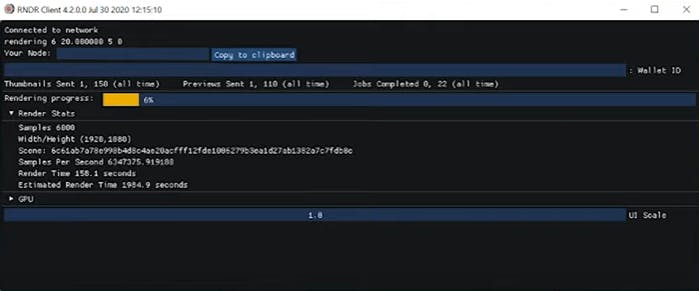
Running the Render Network Client as a node operator : IMG SRC
Job assignment: The Render Protocol automatically assigns the job to a node operator based on the reputation score of the operator and the job specification outlined by the creator.
Job execution: OctaneRender is used by node operators to process the assigned job.
Job completion verification: Node operators render progress can be monitored in real time by creators. The creators can flag processing abnormalities before the job is completed. Previews are watermarked until a job is confirmed.
Payment: Over the course of a rendering job, payments are held in escrow. Once the creator verifies that the job has been completed satisfactorily, the payment in RNDR tokens is released to the node operator. The Render Network receives somewhere in the region of 0.5%-5% of the total amount for facilitating the service. At this point, the creator can download his/her rendered assets.
Node operators are categorized into 3 tiers:
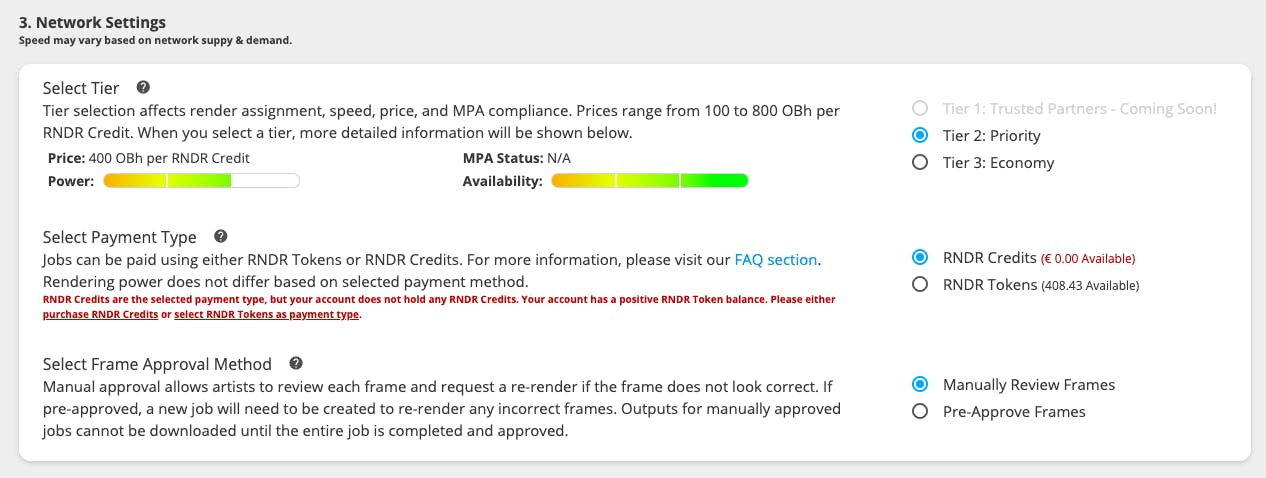
1.Tier 1 - Trusted Partners. Opting for this tier selects the most reputable node operators and costs more. 2.Tier 2 - Priority. This level provides for rendering queue priority with a higher rate payable in exchange for expedited rendering. 3.Tier 3 - Economy. This is the most cost effective option albeit that work may not be rendered within tight deadlines and node operator ratings will not be as high.
Render Network vs. centralized cloud services
In recent years, there has been an ongoing shift towards centralized cloud computing services led by Amazon Web Services (AWS), alongside similar offerings from IBM, Microsoft, Alibaba and Google. According to Gartner, that transition will reach a cloud computing spend of $1.8 trillion by 2025. When it comes to the HPC end of the computing business, only a small percent of the installed server base worldwide has the GPU acceleration needed to carry out high end computation.
For lower end computation, the centralized cloud computing services tend to be cheaper. For HPC, Render Network has an edge. Cloud service companies have a major capital expenditure on GPUs that are depreciating rapidly due to ongoing advancements in GPU technology. By comparison, Render Network doesn’t have that overhead as it is tapping into an array of GPU devices provided by node operators.
This means that the Render Network can be run with a much lower cost base and on much tighter margins than the likes of AWS. Node operators have sunk costs in the GPU devices that they have gone out and bought. From their perspective, the thinking is that they might as well earn something in the hours that the machine is not being used by making it available on the network.
Existing competition - decentralized
Render Network seems to have a free run at HPC compute rendering from the perspective of decentralized projects. Golem Network is an alternative that accesses a pool of distributed computing power. However, it’s not specifically focused on high end compute for rendering purposes. It’s taking a much broader approach than offering rendering, instead providing for distributed cloud computing more generally.
iExec is another such project but as with Golem, it too takes a broader approach and is not focused entirely on high end computing for rendering.
A lot of work has been carried out into researching how wasteful computations as required by Bitcoin’s proof-of-work-based algorithm could be adopted to a system which can both secure a blockchain network while also achieving computations that have real world utility. Perhaps in the distant future, this might come into play for high end rendering but it’s not a threat to Render Network’s offering today.
Exploiting a market opportunity
VR, AR and metaverse worlds are going to require a high level of compute input due to a need for much higher resolution and frame rates. To give you an idea of the intensity of computing capacity required, in the animated movie Toy Story 4, one frame took 325 hours to render. Until now, a system hasn’t existed that allows content creators to tap into such a vast pool of GPU compute capacity as Render Network provides.
That pool of GPU computing capacity is likely to have been fortified more recently. In September, the Ethereum mining business was faced with a need to pivot to other use cases following a successful Ethereum network ‘merge.’ In a recent article, we considered the likelihood of former GPU-based Ethereum miners being repurposed for video rendering. The likelihood of that equipment finding its way onto the Render Network is something that OTOY as the developer of the project has also considered.
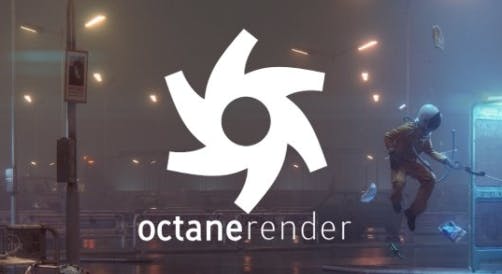
From a tokenomics perspective, Render Network may not be the best bet right now for anyone speculating on the appreciation of the RNDR token as market adoption continues. The native token is inflationary by nature. Additionally, the success of the project doesn’t necessarily depend on the use of the token. It’s possible for clients to access the service without having to buy RNDR tokens.
The idea of redesigning the tokenomics of the project has been floated but until such time as that happens, there’s little incentive to hold RNDR tokens.
That of course does not mean that the project isn’t going to continue to be successful in meeting what is a growing need. Solana co-founder Raj Gokal stated last year that “we will be living in the metaverse faster than anyone thinks”. If we accept that to be the case, then there’s likely to be a considerable volume of rendering jobs to be scheduled on Render Network over the coming years.

